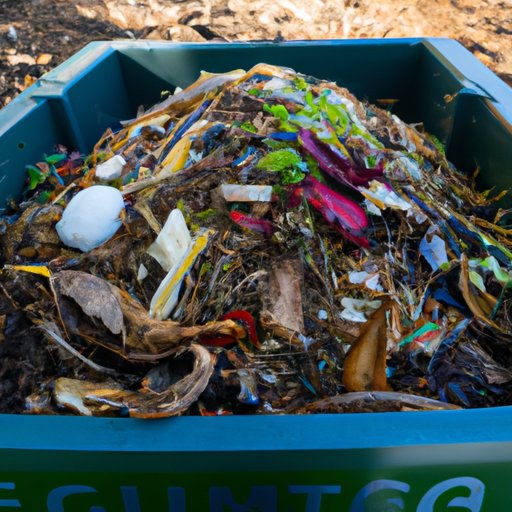Introduction
Composting is a great way to reduce food waste and create nutrient-rich soil for your garden. It’s also an easy and rewarding activity that anyone can do at home. In this article, we’ll walk you through the steps of how to start a compost bin at home.
Definition of Composting
Composting is the process of breaking down organic matter into a nutrient-rich soil amendment. As the organic materials decompose, they create a rich humus (dark, earthy-smelling material) that can be used as fertilizer for gardens and landscapes.
Benefits of Composting
Composting has numerous benefits. According to the U.S. Environmental Protection Agency, composting not only reduces the amount of waste sent to landfills but also helps improve soil structure, increases water retention, and reduces erosion. Additionally, composting can help reduce the need for chemical fertilizers and pesticides, which can have negative impacts on the environment.
Gather the Right Materials
Before starting a compost bin, there are a few materials that you’ll need to gather. First, you’ll need a bin. You can purchase a ready-made bin or build one yourself using wood pallets or other materials. You’ll also need soil, organic material (such as vegetable and fruit peels, eggshells, coffee grounds, and grass clippings), and a shovel.
Decide on the Size and Location of Your Compost Bin
When deciding on the size of your compost bin, consider how much organic material you plan to compost. A small bin will work for a few kitchen scraps, while a larger bin is better suited for larger amounts of compostable material. When choosing a location for your compost bin, pick a spot that receives some sunlight and is close to a water source.
Prepare the Bin
Once you’ve chosen a bin, it’s time to prepare it. If your bin doesn’t already have holes in the bottom and sides, you’ll need to drill them. These holes will allow air to circulate and help speed up the composting process.

Add a Layer of Soil to the Bottom of the Bin
Once your bin is prepared, add a layer of soil to the bottom. This layer will help absorb excess moisture and provide beneficial bacteria and fungi that will aid in the composting process.
Start Adding Organic Material
Now that your bin is prepared, it’s time to start adding organic material. Begin by adding vegetable and fruit peels, eggshells, coffee grounds, and grass clippings. Make sure to mix the materials together and avoid adding too much of any one type of material.

Add a Thin Layer of Soil on Top of the Organic Material
Next, add a thin layer of soil on top of the organic material. This will help keep the material from drying out and provide more beneficial microbes to aid in the composting process.

Turn and Mix the Compost Occasionally
To ensure that all the materials are properly broken down, turn and mix the compost occasionally. This will aerate it and help speed up the decomposition process. Depending on the temperature and humidity, the compost should be ready in 2-6 months.
Conclusion
Composting is a great way to reduce food waste and create nutrient-rich soil for your garden. To start a compost bin at home, you’ll need a bin, soil, organic material, and a shovel. After preparing the bin and adding layers of soil and organic material, turn and mix the compost occasionally to aerate it and speed up the decomposition process. With a little bit of effort and care, you’ll soon have nutrient-rich compost that you can use to nourish your garden.
(Note: Is this article not meeting your expectations? Do you have knowledge or insights to share? Unlock new opportunities and expand your reach by joining our authors team. Click Registration to join us and share your expertise with our readers.)
